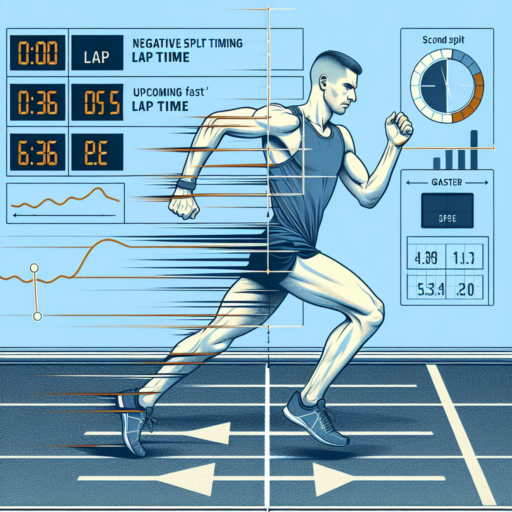Understanding the Concept of Finding Your Pace
Finding your pace in both personal and professional life is crucial for sustainable success and well-being. This concept refers to discovering and maintaining the speed at which you can operate effectively without feeling overwhelmed. It’s about balancing productivity and rest, ensuring that you’re moving forward without compromising your health or happiness. Recognizing that each person’s pace is unique is the first step in this journey.
Benefits of Finding Your Pace
- Increased Productivity: When you find your pace, you can work more efficiently, completing tasks with fewer mistakes and in less time.
- Better Health and Well-being: Avoiding burnout by not overextending yourself preserves your mental and physical health.
- Enhanced Creativity: Working at a comfortable pace allows your mind to relax, making room for more creative thinking and problem-solving.
Understanding your personal limits and preferences plays a significant role in finding your pace. It involves trial and error, as well as a deep understanding of your own goals, strengths, and limitations. By paying attention to how different speeds affect your work and personal life, you can start to adjust your activities and schedules accordingly. This adjustment period is vital for setting a sustainable pace that fosters growth and satisfaction.
Lastly, it’s important to note that finding your pace is an ongoing process. As your life circumstances and priorities change, so too will your optimal pace. Embracing this fluidity can help you maintain balance and productivity through the various stages of your life and career.
Why It’s Important to Find Your Pace in Life and Work
Finding the right pace in both life and work is pivotal for various reasons. It allows for a balanced approach to responsibilities and leisure, ensuring that neither aspect of one’s life overshadows the other. When individuals discover an equilibrium that suits their physical and mental capacities, they pave the way for sustainable productivity and personal contentment. Moreover, understanding and respecting one’s own pace can significantly reduce stress levels and prevent burnout, a common outcome of today’s high-pressure environments.
Finding your pace also fosters a deeper sense of self-awareness. It requires one to be in tune with their needs, capabilities, and limits. This level of self-knowledge is invaluable, as it guides decisions not just in professional contexts but in personal ones as well. Developing this awareness can lead to more fulfilling life choices, from career paths to relationships and hobbies. It’s about recognizing when to push forward and when to ease off, making adjustments as life’s circumstances evolve.
Moreover, setting an appropriate pace can enhance creative and critical thinking. It’s well documented that constant pressure and a hurried lifestyle can stifle innovative thought and decision-making. By finding a rhythm that allows for periods of rest and reflection, individuals can foster an environment where creativity flourishes, ultimately benefiting not just their work output but their overall quality of life. This approach encourages a more mindful engagement with tasks, promoting excellence over sheer volume.
Steps to Discover Your Unique Pace in Various Aspects of Life
Finding your unique rhythm in life is essential for personal growth and happiness. Our pace can drastically vary in different spheres of our existence, such as our careers, relationships, and personal development. By acknowledging and respecting our individual speeds, we cultivate a life that feels more authentic and less pressured by societal expectations. Below are key steps to uncover the pace that feels true to you in the various aspects of your life.
Reflect on Your Values and Priorities
Begin by contemplating what truly matters to you. Identifying your core values and priorities is vital in determining the pace at which you wish to move through life’s various avenues. Consider what aspects of your life deserve more energy and time and which ones can take a backseat. This reflection will guide you in setting a pace that aligns with your personal goals and aspirations.
Experiment with Different Speeds
Exploration is key to discovering your unique pace. Don’t hesitate to experiment with moving at different speeds in your career, hobbies, relationships, and personal growth endeavors. Notice how varying paces affect your mood, productivity, and satisfaction. Through trial and error, you’ll begin to understand which speeds resonate with you and contribute to a sense of fulfillment.
Embracing your unique pace requires patience and mindfulness. It’s about understanding that life is not a race, and moving at a speed that feels right for you is more rewarding than comparing your journey to others. By following these steps, you will uncover a pace that not only suits your current lifestyle but also promotes sustainable growth and happiness.
The Role of Mindfulness in Finding Your Ideal Pace
In today’s fast-paced society, where the pressure to perform is omnipresent, finding your ideal pace can often feel like an insurmountable task. However, mindfulness meditation has emerged as a powerful tool in recognizing and adopting an optimal rhythm for both personal and professional life. By fostering a heightened state of awareness, mindfulness encourages individuals to live in the moment and listen to their body’s needs, enabling a more harmonious balance.
One core aspect of mindfulness in determining your pace is its ability to reduce stress and anxiety. Through practices such as focused breathing and gentle observation of one’s thoughts and feelings without judgment, mindfulness helps in quelling the incessant noise of the mind. This tranquility is essential in making clear, informed decisions about how fast or slow one should move in various aspects of life.
Moreover, mindfulness aids in recognizing the signs of burnout before they become overwhelming. By paying attention to the cues our bodies and minds give us, such as fatigue or a lack of motivation, individuals can adjust their pace accordingly. This self-awareness is crucial in maintaining a sustainable pace that aligns with one’s physical and emotional capacities.
How to Maintain Your Pace Once You’ve Found It
Finding your pace, especially in activities such as running, working, or even in your daily routine, is a significant milestone. However, maintaining this pace is where the real challenge lies. It’s not just about the initial thrill of finding your stride; it’s about keeping it day after day. This entails understanding the symbiosis between body and mind, and engaging in practices that perpetuate your newfound rhythm without leading to burnout.
First and foremost, setting a realistic schedule plays a pivotal role. Your pace should integrate seamlessly with your daily life, enhancing it rather than disrupting it. This means recognizing when you’re pushing too hard or when you might be capable of a little more. It’s a delicate balance, one that requires constant attention and adjustment.
Equally crucial is the aspect of listening to your body and mind. Acknowledging signs of fatigue, whether physical or mental, is not a sign of weakness but of wisdom. It’s essential to incorporate regular intervals of rest and recuperation, ensuring that you’re not only maintaining your pace but doing so in a way that’s sustainable in the long run.
No se han encontrado productos.
Common Challenges in Finding Your Pace and How to Overcome Them
Finding your pace in any aspect of life, whether it’s running, working, or learning, can seem like a labyrinthine journey. This challenge often stems from a misalignment between our expectations and our realities. It’s common to face hurdles along the way, but understanding and overcoming these barriers can significantly smooth the path toward attaining a comfortable and productive rhythm.
Identifying Personal Limitations
One of the foremost challenges many encounter is acknowledging their personal boundaries. It’s easy to fall into the trap of comparison, measuring our progress against others’. This not only dampens our spirit but can also lead to pushing ourselves too hard, resulting in burnout. The key to overcoming this obstacle is by setting realistic, personal goals. Start by understanding your unique capabilities and gradually expand your limits, keeping your health and well-being in priority.
Creating a Consistent Routine
An inconsistent routine is another major hurdle. The irregularity of tasks and activities can make finding a steady pace feel impossible. Overcoming this challenge necessitates the establishment of a structured daily regimen. Incorporating time management techniques, such as prioritization and scheduling, can immensely help in creating a balanced routine that aligns with your pace and goals.
Ultimately, finding your pace is a deeply personal journey that requires patience, self-awareness, and perseverance. Remember, it’s about progress, not perfection. Adapting to setbacks and being flexible in your approaches will equip you to overcome these common challenges effectively.
Real-Life Examples of People Who Found Their Pace Successfully
Finding one’s pace in life can sometimes seem like a daunting journey, but it’s a path well-trodden by many who have come before us. These real-life examples illustrate not just the destination of success but the importance of the journey, persistence, and self-discovery that comes with it. By looking at the stories of individuals who navigated their way through challenges and uncertainties, we can draw inspiration and learn valuable lessons about personal growth and achievement.
Breaking Barriers in Athletics: Eliud Kipchoge
The story of Eliud Kipchoge, the Kenyan long-distance runner, serves as a powerful example of finding and mastering one’s pace. Kipchoge’s journey from a humble beginning to becoming the world record holder in marathon running is a testament to his relentless pursuit of excellence. His philosophy of self-discipline, consistency, and focusing on the process, rather than immediate outcomes, speaks volumes about the essence of finding one’s pace. Kipchoge’s achievements, including his sub-2-hour marathon, underscore the significance of setting personal goals and working steadily towards them.
Path to Innovation: Sarah Blakely
On the entrepreneurial front, Sarah Blakely’s story exemplifies the importance of perseverance and self-belief in finding one’s pace. The journey to becoming the founder of Spanx was filled with challenges, from being rejected by numerous manufacturers to facing skepticism about her product’s viability. Blakely’s determination and her ability to stay the course, coupled with her innovative thinking, eventually led to the creation of a billion-dollar company. Her path to success highlights the power of embracing failures and learning from them as integral steps in pacing oneself towards achieving one’s goals.
These examples reflect the countless paths to discovering and embracing one’s pace. Whether it’s through athletic endeavor, entrepreneurial spirit, or personal development, the journey involves understanding one’s strengths and limitations, setting realistic goals, and being persistent. The stories of Eliud Kipchoge and Sarah Blakely, among others, serve as inspirations, showing that success is achievable through patience, hard work, and a positive mindset.
Tools and Apps That Can Help You Find and Keep Your Pace
In the journey to achieving your running or work goals, finding the right pace is essential. Luckily, the digital age offers a plethora of tools and apps designed to assist both beginners and seasoned individuals. These tools not only help you discover the pace that’s best suited for you but also ensure you maintain it for optimal performance and progress.
Popular Pace-Setting Apps
Several apps have gained popularity for their accuracy and user-friendliness. Apps like Strava and RunKeeper allow users to track their runs, analyze pace, and set goals based on their performance data. They offer a community aspect as well, where you can compare and compete with friends, keeping the motivation high. For those looking for more detailed analytics, MapMyRun provides insights into your running form, suggesting adjustments to improve efficiency and pace.
Wearable Tech for Pace Monitoring
Aside from smartphone apps, wearable technology has revolutionized how we monitor our performance. Devices such as the Garmin Forerunner series and Apple Watch are equipped with advanced sensors to track your pace, heart rate, and even suggest recovery times. These wearables provide real-time feedback, allowing for adjustments on the go to ensure you’re always at your target pace.
Getting the right tools and understanding how to use them effectively can transform your running experience or any goal-oriented task. Embracing these tools and apps not only helps in finding your ideal pace but also in keeping it, leading to improved outcomes and a more enjoyable journey.
Adjusting Your Pace: When and How to Make Changes
Adjusting your pace, whether in life, work, or physical activities, is essential for maintaining balance and achieving success. Recognizing when to make these adjustments can often be as crucial as understanding how to implement them effectively. This process involves being in tune with your goals, capabilities, and the signs indicating a need for change.
Signals Indicating a Need for Pace Adjustment
Several signs may suggest it’s time to adjust your pace. These include feeling overwhelmed or underwhelmed, hitting a plateau in progress, or experiencing a significant change in your personal or professional life. Physical symptoms, such as increased fatigue or persistent stress, can also serve as indicators that your current pace may not be sustainable or appropriate for your current situation.
Effective Strategies for Pace Adjustment
Once you’ve recognized the need for a change, the next step is understanding how to adjust your pace effectively. This might involve setting new, more realistic goals, reevaluating your priorities, or implementing time management techniques. For many, it could also mean seeking feedback or assistance from peers, mentors, or professionals who can provide insight and advice tailored to your specific circumstances.
Finding Your Pace for Long-term Success and Fulfillment
Finding the right pace in life and work is essential for long-term success and fulfillment. In a world that often values speed over quality, taking the time to discover your own pace can seem counterintuitive. However, it’s this very process that can lead to more meaningful achievements and a deeper sense of satisfaction. Everyone’s journey is unique, and understanding that your pace may differ from others is crucial in setting realistic goals and expectations for yourself.
One of the first steps in finding your pace is self-reflection. This means taking stock of your personal and professional goals, your work habits, and your lifestyle. It’s also important to consider your health and well-being as central components of your pace. Balance is key; pushing yourself too hard can lead to burnout, while not challenging yourself enough can result in stagnation. Listening to your body and mind, and recognizing when you need to speed up or slow down, are skills that come with practice and attention.
Another aspect to consider is the impact of your pace on long-term success and fulfillment. Success is often seen as a series of achievements, but true fulfillment comes from the journey and the quality of your experiences along the way. By finding your pace, you allow yourself the room to enjoy the process, learn from it, and adapt as necessary. This not only leads to better outcomes but also ensures that you derive satisfaction from your efforts, regardless of the results.




